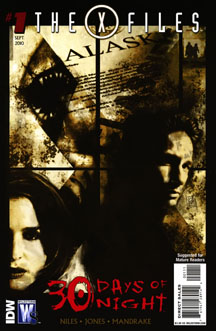As a fan delves deeper into his favorite TV series, he’ll inevitably start to wander down the rabbit hole of crossovers. In addition to the obvious connections to “Millennium” and “The Lone Gunmen,” “The X-Files” is arguably also part of the same universe as “Homicide: Life on the Street” and “Law & Order: SVU” due to Det. John Munch (Richard Belzer) appearing in Season 5’s “Unusual Suspects.” And the Season 2 episode “Red Museum” loosely links with “Picket Fences.” Mulder and Scully also appeared on “The Simpsons.”
But – aside from fellow Carter-verse shows “Millennium” and “The Lone Gunmen” – the most effective “X-Files” crossover is the “X-Files”/”30 Days of Night” six-issue comic series from Wildstorm and IDW in 2010-11. It’s co-written by “30 Days of Night” creator Steve Niles and – as it’s set during the 1990s, when M&S work for the FBI – it serves as a prequel to the proper “30 Days of Night” series. Whether a fan wants to link it with “30 Days of Night” comics or movie franchise is another rabbit hole of discussion.
Regardless, this is a richly realized series that slathers the pages with almost as much storytelling intrigue as gore-encrusted killings. As with Season 1’s “Ice” and Topps comics Issues 8-9, “Silent Cities of the Mind,” the action is set in the snow-covered Alaskan wilderness. Artist Tom Mandrake effectively captures the isolation of this locale, starting with a trucker who comes upon a graveyard of crashed trucks and a grisly tableau that would make Hannibal Lecter proud: A dozen headless corpses are frozen into a totem display, with the heads arranged at the base.
“The X-Files” loosely tackled vampires twice during the TV run – in Season 2’s “3,” one of the series’ most loathed episodes, and Season 5’s “Bad Blood,” one of the most beloved episodes. But “30 Days of Night” is a comparatively serious and detailed take on vampire lore. Mulder suspects from the get-go that vampires are to blame for the killings – although, similar to “The Walking Dead” not using the word “zombie,” he never actually says “vampire.”
Thankfully, it’s not a case of going through the motions as Niles’ and Adam Jones’ yarn unspools. Rather, we learn about the specifics of the “30 Days of Night” mythology, complete with a limbless former sea captain who had been cursed with eternal life (or unlife, as it were) by the creatures; native Inuit who know they must fight off the beasts until sunlight returns; and Russian agents stationed just on the other side of the boundary line who are hunting the monsters.
Similar to “The Strain,” although with a bit less ancient mythology, we see that the traditional rules loosely apply – sunlight is bad for the creatures, and a bullet through the head isn’t enough to kill one. But these are not sexy Dracula-style vampires. Although they talk to each other in their own language and have a culture of sorts, they attack with viciousness and psychological cruelty, as the opening tableau suggests.

Mandrake delivers evocative images like an icebreaker ship caught in the ice for decades, the FBI’s makeshift encampment, and the small town itself: Wainwright, a real-life town of about 500 people not too far (in Alaska terms) from Barrow, where the primary “30 Days of Night” saga takes place. Furthering the geography lesson, the Russians have a base on their Big Diomede Island, which neighbors the U.S. island of Little Diomede.
Mulder’s conflict with Federal Agent Robert Daniel French, who Mulder denigrates with the name “Frenchy” in payback for the man “riding (him) since Quantico” for his “spooky” theories, is a bit clichéd — both in the sense of having a human villain amid a horror yarn and in the sense of Mulder being taunted with “Spooky.” On the plus side, I love that the Russian base features agents who are fans of M&S’s work, as they head up the Russian equivalent of the X-Files. (It’s too bad Mulder couldn’t team up with those Russian allies during his adventures in Season 4’s “Tunguska.”) I also like how Skinner stands up for Mulder and Scully when French whines about their involvement.
In the end, I almost want to watch the 2007 “30 Days of Night” movie to experience the “sequel” to this “X-Files” story (although the absence of M&S would no doubt be a letdown). At any rate, in the often highly commercialized realm of comic-book crossovers, “X-Files”/”30 Days of Night” is one of the good ones, as it makes logical sense and respectfully showcases both franchises.

